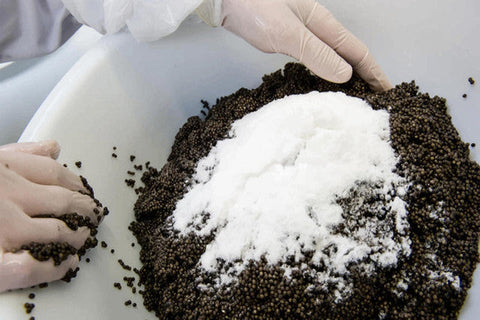Once roe is harvested from the fish, it doesn’t become caviar until it’s properly processed—and that means curing. Curing is essential not only for flavor development but also for preservation, and the primary agent used in this process is salt. Depending on the quality of the eggs and the intended shelf life, producers choose from three common curing methods, each with varying levels of salt. Understanding the processing methods to cure and preserve caviar can help you make informed choices when purchasing caviar and deepen your appreciation for this delicacy.
The Importance of Salt: From Subtle to Strong
Not all caviar is created equal, and neither is all salt-curing. The method and amount of salt used are directly tied to the quality and intended purpose of the roe. The three primary categories of caviar preservation include malossol, pressed, and semi-preserved. Let’s take a closer look:
- Malossol: The Gold Standard of Caviar
Malossol means “little salt” in Russian, and this technique is considered the highest quality method for preserving fresh caviar. Malossol caviar typically contains less than 5% salt, just enough to enhance the flavor and extend shelf life without overwhelming the natural taste of the roe. In some regions, borax may be added (where legally permitted) to reduce the amount of salt needed while maintaining safety standards.
Because this method relies on pristine roe, only the best eggs—firm, intact, and uniformly sized—are selected for malossol curing. This results in a luxurious, clean taste with delicate brininess, ideal for showcasing premium sturgeon species like Osetra, Beluga, or Kaluga.
- Pressed Caviar: A Concentrated Delight
When roe doesn’t meet the high standards required for malossol—whether due to being overly ripe, soft, or slightly damaged—it may be processed into pressed caviar. This method begins with curing the eggs using slightly more salt than malossol. After curing, the roe is gently pressed into a dense, jam-like paste.
While pressed caviar may sound like a downgrade, it's actually revered among caviar aficionados for its intense, rich flavor. This variety is often used as a spread or garnish, lending a punch of umami and brininess to dishes.
- Semi-Preserved (Salted) Caviar: Long-Lasting and Bold
The most heavily salted option is known as semi-preserved or “salted” caviar. With a salt content typically around 8% or higher, this method prioritizes longevity over nuanced flavor. It’s commonly used for more affordable fish roes, such as lumpfish or capelin, which are often used in larger-scale food production.
Due to its high salt concentration, semi-preserved caviar may also contain added preservatives like sodium benzoate. While it offers an extended shelf life and room temperature stability, this processing method tends to mute the natural flavors and alter the texture of the roe.
Storage and Shelf Life: What to Expect
Each curing method has its own set of storage requirements. Malossol caviar is best kept between 26°F and 36°F in vacuum-sealed jars or banded tins. It remains fresh for up to two months when refrigerated, but can be frozen or pasteurized to extend shelf life beyond a year, though freezing may impact texture and flavor.
Pressed and semi-preserved caviars are also vacuum-sealed but differ in how they’re stored. Pressed caviar still requires refrigeration to maintain quality. Semi-preserved varieties, thanks to their high salt and preservative content, are more shelf-stable and can often be stored at room temperature without spoiling.
Choosing the Right Caviar for Your Taste and Table
Whether you’re indulging in delicate malossol or enjoying the robust flavor of pressed caviar, knowing how your caviar was cured helps you appreciate both its heritage and its craftsmanship. When you understand the role of salt and preservation, every tin of caviar becomes more than just a luxury—it becomes a story of tradition, technique, and taste.



